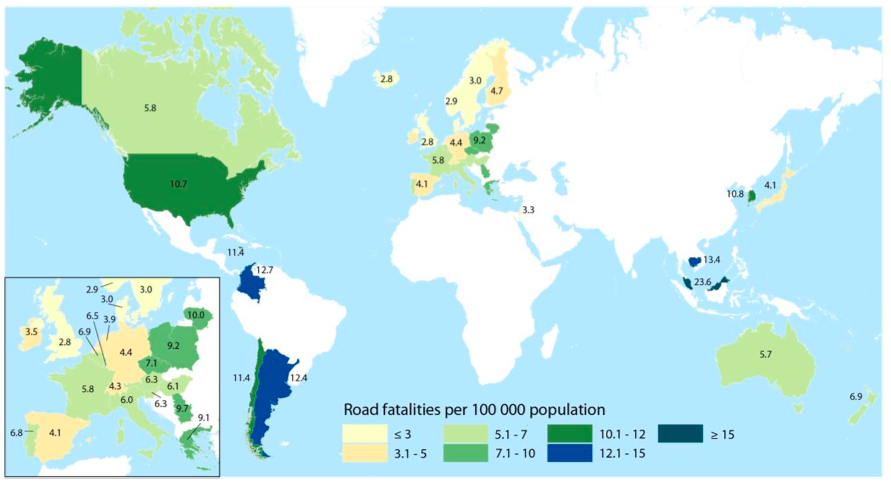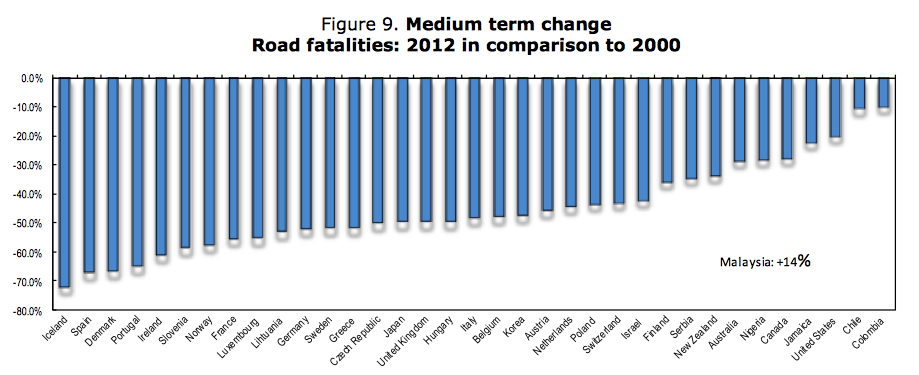Street Safety Lags in America
America is failing at improving road safety, but how is Wisconsin doing?

This map shows traffic fatalities per 100,000 residents. Image: International Transport Forum. Click to enlarge
A new report from the International Transport Forum shows America is only falling farther behind all of its peer nations on street safety [PDF].
The traffic fatality rate in the United States (10.7 per 100,000 people) is nearly four times higher than in the United Kingdom (2.8 per 100,000) and close to double that of Canada (5.8). To put that in perspective, if America had the same traffic fatality rate as the U.K., around 25,000 fewer people would be killed every year.
America’s street safety record puts it near the bottom of the ITF’s ranking of 35 countries, far behind most other developed nations.
Traffic deaths have generally been declining in America, but not nearly as fast as in other countries. From 2000 to 2012, the U.S. managed to lower traffic death rates just 20 percent. Even Australia, another laggard that ITF grouped among nations with the “least success” reducing traffic deaths, still managed to cut fatalities 28.5 percent. Meanwhile, high performers Denmark, Spain, and Portugal all reduced fatality rates 65 percent or more over the same period.
Preliminary data from 2013 indicate nine countries – Austria, the Czech Republic, France, Greece, Lithuania, the Netherlands, New Zealand, Portugal and Switzerland — reduced fatality rates more than 10 percent in a single year.

The United States was one of the worst performers among developed nations on decreasing traffic fatalities over the last decade. Image: International Transport Forum
America’s dismal performance does not reflect a lack of resources. Sometimes “safety” expenditures in the United States include massive projects like Wisconsin’s $1.7 billion Zoo Interchange, justified in large part by its supposed role in reducing collisions.
As we’ve reported before, the old road safety paradigm in the U.S. is broken. ITF notes that American safety initiatives over the last few decades have focused on making driving safer with enhanced technology in cars (airbags), efforts to increase seat belt usage, and cracking down on drunk driving.
In the UK and France, for example, key initiatives have included the proliferation of 20 mph zones in many UK cities and, soon, throughout Paris. ITF reports that France has also increased the use of red-light and speed cameras as a key policy initiative to prevent traffic deaths.
Speed reduction seems to be especially important in reducing pedestrian and cyclist fatalities, where American performance has been particularly poor compared to peer nations. In the U.S., pedestrians accounted for a much greater share of road fatalities in 2012 (29 percent) than in 2000 (18 percent).
In the UK, meanwhile, pedestrian deaths are falling as a share of overall traffic fatalities. The number of pedestrians killed in that nation declined 75 percent between 1990 and 2012, compared to a 66 percent drop among motor vehicle occupants. Pedestrians are especially vulnerable to speeding motorists, and the U.K.’s efforts to reduce speeding appear to be paying off. ITF reports that speed is a factor in 12 percent of road fatalities in the U.K., compared to 30 percent in the U.S.
How is Wisconsin Doing?
According to the Insurance Institute for Highway Safety, in 2012 Wisconsin’s was simply meeting the world-trailing American average of 10.7 road fatalities per 100,00 people.
But it appears that Wisconsin has been making some progress. According to a Wisconsin Department of Transportation press release, as of August 31, 320 people had died in traffic crashes during 2014 on Wisconsin’s roads. This is 28 fewer than during the same period in 2013 and 44 fewer than the five-year average. Unfortunately, August had a spike of 69 fatalities, which was higher than the August 2013 total of 65.
One category where it appears Wisconsin is doing better than the country is in regards to pedestrian safety, as 22 pedestrians, or only 6.9% of road fatalities were pedestrians this year.
Despite the recent progress, until Wisconsin (and Milwaukee) follows the world’s lead and expands the use of 20 mph speed limit zones it is an open question as to whether or not our roads will ever approach the safety levels seen in the rest of the industrialized world. – Dave Reid
Story by Angie Schmitt with additional contributions from Dave Reid of Urban Milwaukee. A version of this story originally ran on Streetsblog. Angie Schmitt is a newspaper reporter-turned planner/advocate who manages the Streetsblog Network from glamorous Cleveland, Ohio. She also writes about urban issues particular to the industrial Midwest at Rustwire.com.
Streetsblog
-
Car Culture Cements Suburban Politics
![Sprawl. Photo by David Shankbone (David Shankbone) [GFDL (http://www.gnu.org/copyleft/fdl.html) or CC-BY-SA-3.0 (http://creativecommons.org/licenses/by-sa/3.0/)], via Wikimedia Commons [ https://commons.wikimedia.org/wiki/File%3ASuburbia_by_David_Shankbone.jpg ]](https://urbanmilwaukee.com/wp-content/uploads/2017/10/1024px-Suburbia_by_David_Shankbone-185x122.jpg) Nov 23rd, 2018 by Angie Schmitt
Nov 23rd, 2018 by Angie Schmitt
-
Most Drivers Don’t Yield to Pedestrians
 Mar 22nd, 2018 by Angie Schmitt
Mar 22nd, 2018 by Angie Schmitt
-
Jobs Up Yet Driving Down in Seattle
 Feb 22nd, 2018 by Angie Schmitt
Feb 22nd, 2018 by Angie Schmitt


















The speed limit could be 5 mph but would do nothing if its not enforced. I wonder how well those limits are enforced in Europe and how severe the penalties are for breaking the limit.
Here everyone acceots that you can be clocked at 9 over without any repercussions, effectively making the speed limit here in town 40-50 mph with many drivers regularly doing >50.
Fatalities per 1,000 population is a terrible way to compare these countries. At least fatalities per vehicle mile (or km) traveled would be somewhat legitimate. Which if you look at those statistics, we’re right in the mix with many European countries, along with Canada, Australia, New Zealand, and others. Not that safety isn’t a concern, but it just seems illogical to make this comparison in the way done here.
Both comparisons can be helpful. Deaths per mile might give us a better picture of driver behavior while deaths per 1,000 can give us a better idea of what that insfrastructure is like.
I don’t view American’s any less safer or dangerous than their Euro conterparts and have been terrified plenty in latin countries and the deaths per mile would probably back that up.
While in Europe the infrastucture means people don’t have to drive as much and because of this there are less deaths. Wouldn’t it be nice if our cities we built back to a human scale again? I’m sure if they did the amount of deaths would be lower per 1,000 while out on the long distance high speed hiways the numbers would still be the same.
Enforcement is important for a 20mph speed limit to work – red-light cameras and speed cameras should play an important role here.
However, even more important is design. Design and build wide streets with wide lanes and you’ll get high speeds. Design and build streets to encourage slower speeds and that’s also largely what you’ll get. We need narrow lanes, curb extensions/bulb outs, bus bulbs, raised crosswalks, improved bike infrastructure, and similar measures that will help to discourage high speeds on city streets.
Andy, I don’t believe we are anywhere near Canada and Australia in terms of deaths per 100,000 miles driven. I agree that most of Europe has better rail infrastructure which requires less driving, but Australia and Canada are very much like the US. Neither has much in the way of inter-city rail, yet each has roughly half the death rate of the US.
Even more impressive is that Canada achieves its lower death rate without a national system of freeways (like our Interstates). That a country with much more dependence on 2-lane and undivided 4-lane roads (not to mention worse winter weather) can beat us on this so badly is embarrassing.
Also, I think that measuring traffic deaths per 100,000 population (instead of per 100,000 miles driven) is better. We are comparing lifestyles, not traffic engineering. The whole point is that other countries (and some parts of the US) manage to live full lives including travel without needing to drive so many miles. Should we measure obesity per calories consumed? Do we say heroin overdose deaths aren’t really that bad because there’s so much heroin available these days?
The whole point of studies like this is to show how dangerous our American lifestyle is. America is addicted to driving and that addiction is getting people killed left and right. Traffic deaths are so common that many consider them normal and un-newsworthy (once the lanes are re-opened).
There are safer alternatives, like rail transit. To see how safe rail transit is, read and think about the next paragraphs.
Last December, four passengers were killed when a commuter train derailed in New York City. This was huge news (NYC TV programming was preempted, the governor rushed to the scene; it even made the front page of the Journal-Sentinel).
Why was this big national news? Because, unlike multi-fatality car crashes (which are fairly common), a train wreck this bad was highly unusual. It was the worst NYC train wreck in 22 years. It was the first accident with a passenger fatality EVER on this particular railroad (which was founded in 1983).
The lack of rail deaths in NY isn’t because there are few passengers. The NYC subway ALONE carries more passenger miles than ALL Milwaukee County roads (and NYC has 7 other passenger train operators). Since 1928, the worst NYC subway accident killed five people (even though each subway train can (and often does) carry 1,000 or more passengers). In the 85 years since 1928, how many Milwaukee traffic crashes have killed five or more?
Tom D, I get what you’re saying and I don’t disagree that rail is safer and getting more people to ride rail would lower the transportation deaths.
However, that is not what the article presumes to discuss. This is purportedly about how safe our streets are. When you compare the actual safety of our roads you need to look at fatalities per VMT and not per population. The US is not out of whack with Canada and Australia and others. A look at a few, the US is about 20% higher than Canada, 8% lower than New Zealand, within 9% of France, and 8% below Belgium. I cherry picked a few above and below… but I’m just saying it’s not as dramatic as you claim.
In addition, my reasoning for not measuring it based on population but instead by VMT (or VKT as it is in this case) is the same reason we wouldn’t gauge rail safety by population rather than total passenger miles or miles of rail line. If we did, the EU would appear to have a vastly inferior rail system in regards to safety when compared to the US. After all, the EU, with less than twice the population of the US has almost three times the number of rail deaths. Do you really think that’s an accurate reflection on the EU rail system’s safety record?
I think the article also presumes speed is the root cause of the difference in Wisconsin and not something social, like drunk driving. The change in cab regulations in Milwaukee may end up having an important effect on the statistics ultimately.
Heck, you might also suppose that the difference between Europe and Wisconsin means that Wisconsin needs more roundabouts.
In any event, I think the idea that “we need more 20 mph zones” is a simplistic answer that may not be useful at all for a complicated transportation system. Maybe it is an answer, but the case is sloppy and full of holes.
The phrase “safety hdarzas that were ignored” is a misconception based on a fallacy. is something that is , so as the United States , safety improved dramatically (90% drop in workplace fatalities from 1923 to 2003). The construction of the transcontinental railroad was not less safe than current construction because hdarzas were ignored, , but because the country was less wealthy so that the costs of making jobs safer were in that era simply unaffordable. The construction of the transcontinental railroad made the country richer so contributed to safety. (For example, deaths due to transportation accidents dropped by about sixty fold with travel by rail instead of by horse.) (Noting that any effect of government regulation with the creation of OSHA is undetectable.)